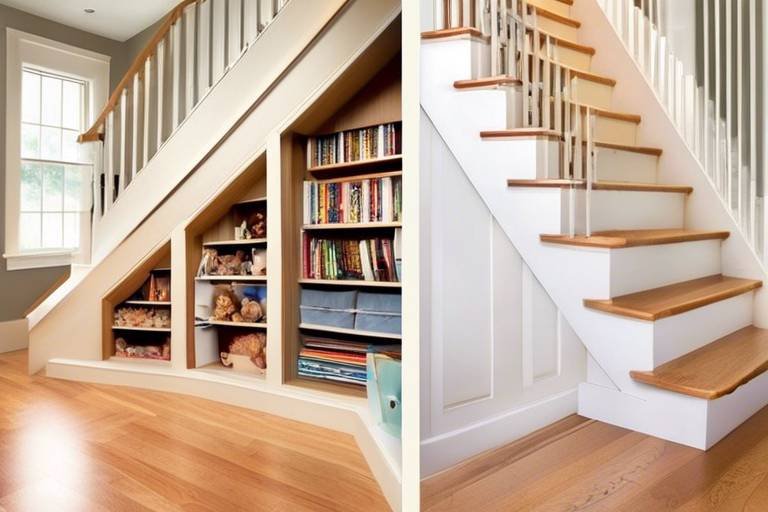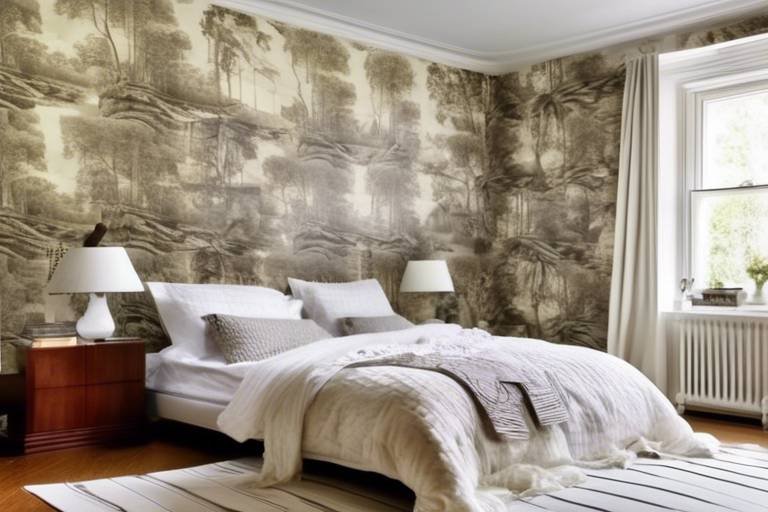The Ultimate Guide to Choosing Furniture for a Home Renovation
Are you ready to embark on a home renovation journey that will transform your living space into a stylish and functional oasis? Choosing the right furniture is a crucial step in this process, as it sets the tone for the entire design scheme. From sleek modern pieces to timeless traditional styles, the options are endless, but fear not - this ultimate guide will steer you in the right direction.
Before diving into the exciting world of furniture shopping, take a moment to assess your needs and style preferences. Consider how you use each room, your design aesthetic, and the level of comfort and functionality you require from your furniture. By understanding these key elements, you can make informed decisions that align with your lifestyle and vision for your home.
Setting a realistic budget is essential when selecting furniture for your renovation project. By establishing a clear budget, you can prioritize your purchases, strike a balance between quality and cost, and avoid any financial surprises along the way. Remember, investing in quality pieces that will stand the test of time is always a wise choice.
Measuring your space accurately is a fundamental step in the furniture selection process. Take note of the dimensions of each room, doorways, and any architectural features that may impact furniture placement. This will ensure that the pieces you choose not only fit seamlessly into your space but also enhance the overall flow and functionality of your home.
As you explore different furniture styles, from sleek and minimalist to ornate and eclectic, consider how each option complements your existing decor and personal taste. Mixing and matching styles can add depth and visual interest to your space, creating a unique and personalized look that reflects your individuality.
When it comes to quality versus affordability, aim for a balance that meets your needs and budget. Look for well-crafted pieces that offer durability and longevity, without breaking the bank. Remember, investing in quality furniture is an investment in the comfort and style of your home for years to come.
Maximizing storage solutions is key, especially in smaller or multi-functional spaces. Consider furniture that offers built-in storage options, such as ottomans with hidden compartments or bed frames with drawers. Smart organizational solutions can help keep clutter at bay and make the most of every inch of your home.
Choosing sustainable and eco-friendly furniture options is not only good for the planet but also for your health and well-being. Look for pieces made from natural, non-toxic materials, and consider furniture that is certified as environmentally friendly. By making conscious choices, you can reduce your carbon footprint and create a healthier home environment.
Seeking professional advice and inspiration can be invaluable during the furniture selection process. Whether consulting with an interior designer or visiting showrooms for ideas, tapping into expert knowledge can help you refine your vision and make confident choices. Take advantage of resources that offer insights and guidance tailored to your unique renovation needs.

Assessing Your Needs and Style Preferences
When embarking on a home renovation journey, one of the crucial initial steps is assessing your needs and style preferences. Your home should be a reflection of your personality, lifestyle, and unique taste. Take a moment to ponder on how you use each space in your home. Do you need a cozy corner for reading, a functional workspace, or a stylish entertainment area? Understanding your daily routines and activities will guide you in selecting furniture that not only looks good but also serves a practical purpose.
Moreover, consider your style preferences. Are you drawn to sleek, minimalist designs, or do you prefer the warmth of traditional furniture pieces? Your furniture choices should harmonize with the overall aesthetic you want to achieve in your home. Think about the colors, textures, and materials that resonate with you. Creating a mood board or collecting inspiration from design magazines can help you visualize how different styles will come together in your space.
Additionally, think about the future when assessing your needs. Are you planning to expand your family, work from home more often, or host frequent gatherings? Anticipating potential lifestyle changes will ensure that the furniture you choose remains functional and relevant for years to come. Flexibility and adaptability are key factors to consider when selecting pieces that can evolve with your changing needs.
Remember, your home is a canvas where you can express yourself and create a sanctuary that reflects who you are. Assessing your needs and style preferences is the foundation upon which you can build a cohesive and personalized living space that brings you joy and comfort every day.

Setting a Realistic Budget
When embarking on a home renovation project, one of the crucial aspects to consider is setting a realistic budget for your furniture purchases. Without a clear budget in place, it's easy to get carried away and overspend, potentially compromising other areas of your renovation. By establishing a budget upfront, you can prioritize your spending, ensuring that you allocate funds wisely across different furniture items.
Creating a budget also allows you to strike a balance between quality and cost. While it's tempting to opt for the most luxurious pieces, it's essential to consider the long-term value of your purchases. Quality furniture may come at a higher price, but it often lasts longer and withstands daily wear and tear, ultimately saving you money in the long run.
Moreover, a realistic budget helps you avoid impulse buys and stay focused on your renovation goals. By knowing how much you can afford to spend on furniture, you can make informed decisions that align with your overall design vision and style preferences. Remember, a well-thought-out budget doesn't restrict your choices; instead, it empowers you to make smart and intentional furniture selections.
Consider creating a spreadsheet or a detailed list of furniture items you need along with their estimated costs. This approach allows you to track your expenses, identify potential areas for savings, and stay within your budget limits. Additionally, don't forget to factor in additional costs such as delivery fees, assembly charges, and any unexpected expenses that may arise during the renovation process.
Lastly, be open to exploring a mix of high and low-priced furniture options to achieve a balanced look without exceeding your budget. Combining investment pieces with more affordable finds can elevate the overall aesthetic of your space while ensuring that you stay within your financial means. Remember, setting a realistic budget isn't about restricting your choices; it's about making thoughtful decisions that enhance your home renovation experience.

Measuring Your Space
When it comes to selecting furniture for your home renovation, one of the most critical steps is . Accurate measurements of the rooms where the furniture will be placed are essential to ensure that the pieces you choose fit well and complement the overall design of your home. Imagine buying a beautiful sofa only to realize it's too large for your living room or a dining table that doesn't fit comfortably in your dining area. To avoid such mishaps, grab a measuring tape and jot down the dimensions of the spaces where you plan to place your furniture.
Creating a floor plan can also be incredibly helpful in visualizing how different furniture pieces will fit within the room. You can use online tools or simply sketch it out on paper. This way, you can play around with various arrangements without having to move heavy furniture multiple times. Additionally, consider the flow of traffic within the room and ensure there is enough space for movement around the furniture.
Moreover, don't forget to measure doorways, staircases, and any other entry points through which the furniture needs to pass. There's nothing worse than purchasing a stunning wardrobe only to find out it can't make it through the door. By measuring these access points beforehand, you can save yourself from potential headaches and returns.

Exploring Different Furniture Styles
When it comes to for your home renovation, the options are vast and varied. Each style brings its own unique charm and character to a space, allowing you to express your personality and design preferences. From sleek and minimalist modern pieces to ornate and classic traditional furniture, the world of interior design offers a plethora of choices to suit every taste.
Modern furniture styles often feature clean lines, understated elegance, and a focus on functionality. These pieces are ideal for creating a contemporary and uncluttered look in your home, perfect for those who appreciate simplicity and minimalism. On the other hand, traditional furniture styles exude warmth, richness, and a sense of history, adding a timeless appeal to any room.
For those who prefer a more eclectic approach, mixing and matching different furniture styles can result in a visually dynamic and personalized space. By combining elements from various design eras and cultures, you can create a unique and eclectic look that reflects your individuality and creativity.
Exploring different furniture styles also involves considering the materials, colors, and textures that best complement your overall design vision. Whether you opt for sleek metal finishes, rustic wooden accents, or luxurious upholstery, each choice contributes to the ambiance and aesthetic of your home.
Ultimately, the key to successfully exploring different furniture styles lies in finding a balance that resonates with your personal taste and enhances the overall look and feel of your living spaces. By mixing and matching pieces from various styles, you can create a harmonious and visually captivating environment that truly reflects your style and personality.

Quality vs. Affordability
When it comes to choosing furniture for your home renovation, striking a balance between quality and affordability is essential. Quality furniture typically comes with a higher price tag due to superior materials and craftsmanship, ensuring durability and longevity. On the other hand, affordable options may be more budget-friendly but could compromise on quality and longevity.
One approach to finding the right balance is to consider investing in key pieces of high-quality furniture that will serve as focal points in your home. These pieces can anchor the design scheme and withstand the test of time, while complementing them with more affordable accessories and accent pieces to complete the look.
Another strategy is to research and compare different brands and materials to identify options that offer a good balance between quality and affordability. Look for furniture manufacturers known for their craftsmanship and attention to detail, even in their more budget-friendly lines.
Additionally, consider the long-term cost of furniture purchases. While investing in higher-quality pieces may require a larger upfront investment, they may ultimately save you money in the long run by lasting longer and requiring fewer replacements.
Ultimately, the decision between quality and affordability will depend on your personal preferences, budget constraints, and long-term goals for your home renovation. By carefully evaluating your options and priorities, you can find furniture that meets both your quality standards and budget requirements.

Maximizing Storage Solutions
When it comes to maximizing storage solutions in your home renovation, it's essential to think creatively and strategically. One effective approach is to invest in multifunctional furniture that serves dual purposes, such as a storage ottoman that also acts as a coffee table. These versatile pieces not only save space but also add functionality to your living areas.
Another smart storage solution is to utilize vertical space effectively. Consider installing wall-mounted shelves or cabinets to keep items off the floor and create a sense of openness in smaller rooms. Vertical storage not only maximizes space but also adds a decorative element to your home.
Additionally, incorporating smart organizational solutions can make a significant difference in how you utilize storage in your home. Drawer dividers, closet organizers, and storage bins can help keep clutter at bay and ensure that every item has its designated place. By maintaining an organized space, you can make the most of your storage options.
When selecting furniture for your home renovation, prioritize pieces that offer built-in storage options. For example, a bed frame with drawers underneath or a dining table with built-in shelving can provide extra storage without sacrificing style. These furniture pieces not only serve their primary function but also contribute to a clutter-free environment.
Lastly, don't overlook the potential of hidden storage solutions. Consider furniture with hidden compartments or secret storage areas that blend seamlessly into the design. From ottomans with hidden trays to sofas with storage compartments, these discreet storage options can help maintain a clean and organized look in your home.

Choosing Sustainable and Eco-Friendly Options
When it comes to choosing furniture for a home renovation, opting for sustainable and eco-friendly options is not only a responsible choice but also a trend that is gaining momentum in the interior design world. By selecting environmentally conscious furniture pieces, you can contribute to a greener home renovation while reducing the carbon footprint of your living space.
One of the key aspects of choosing sustainable furniture is to look for materials that are eco-friendly and sourced ethically. Materials such as reclaimed wood, bamboo, recycled metal, and organic cotton are excellent choices for environmentally friendly furniture pieces that are both stylish and sustainable.
Additionally, consider furniture that is certified by reputable organizations such as the Forest Stewardship Council (FSC) or Cradle to Cradle (C2C) for their commitment to sustainable practices. These certifications ensure that the furniture has been produced using environmentally responsible methods and materials.
When selecting eco-friendly furniture, also pay attention to the manufacturing process and the impact it has on the environment. Look for furniture brands that prioritize energy efficiency, waste reduction, and carbon neutrality in their production practices to minimize environmental harm.
Furthermore, choosing furniture that is designed for longevity and durability is essential in creating a sustainable home environment. Opt for well-crafted pieces that are built to last, reducing the need for frequent replacements and ultimately decreasing waste generation.
By incorporating sustainable and eco-friendly furniture options into your home renovation, you not only enhance the aesthetic appeal of your living space but also contribute to a more sustainable future for the planet. Making conscious choices in furniture selection can have a significant impact on the environment and promote a greener lifestyle.

Seeking Professional Advice and Inspiration
When it comes to embarking on a home renovation journey, seeking professional advice and inspiration can be a game-changer. Interior designers are like the navigators of the design world, guiding you through the vast sea of furniture options and style choices. Their expertise can help you avoid design pitfalls and ensure that your vision for the renovation is brought to life in the most spectacular way possible.
Visiting showrooms is another excellent way to gather inspiration for your furniture selection. Seeing different furniture pieces in person, arranged in various settings, can spark creativity and provide a tangible sense of how certain styles or layouts might work in your own home. Showrooms offer a hands-on experience that online browsing simply cannot match, allowing you to touch, feel, and visualize the furniture in your space.
Moreover, professionals in the field can offer valuable insights into the latest design trends, innovative furniture solutions, and practical tips for optimizing space and functionality. Their knowledge extends beyond what meets the eye, delving into the realm of ergonomics, material quality, and the art of creating harmonious living environments.
Collaborating with experts not only streamlines the furniture selection process but also opens doors to unique design possibilities that you may not have considered on your own. By tapping into their wealth of experience and creativity, you can elevate your home renovation project from ordinary to extraordinary, turning your living space into a true masterpiece of design and functionality.
Frequently Asked Questions
- How do I determine the right furniture style for my home renovation?
Consider your personal preferences, existing decor, and the overall theme of your renovation project. Explore different styles such as modern, traditional, or eclectic to find a look that resonates with your aesthetic taste.
- What factors should I consider when setting a budget for furniture purchases?
Take into account the quality of the furniture, the number of pieces needed, and any additional expenses such as delivery and assembly. Prioritize essential items and allocate funds accordingly to stay within your budget.
- Why is it important to measure my space before buying furniture?
Accurate measurements ensure that the furniture fits properly in the designated area, preventing overcrowding or mismatched pieces. It also helps you visualize the layout and flow of the room to create a harmonious living space.
- How can I balance quality and affordability when choosing furniture?
Look for reputable brands known for their craftsmanship and durability. Consider investing in key pieces that will last long-term while supplementing with more budget-friendly options for accent pieces or accessories.
- What are some sustainable furniture options for an eco-friendly home renovation?
Opt for furniture made from recycled materials, sustainably sourced wood, or with low VOC finishes. Look for certifications such as FSC or GREENGUARD to ensure that the products meet environmental standards.



















